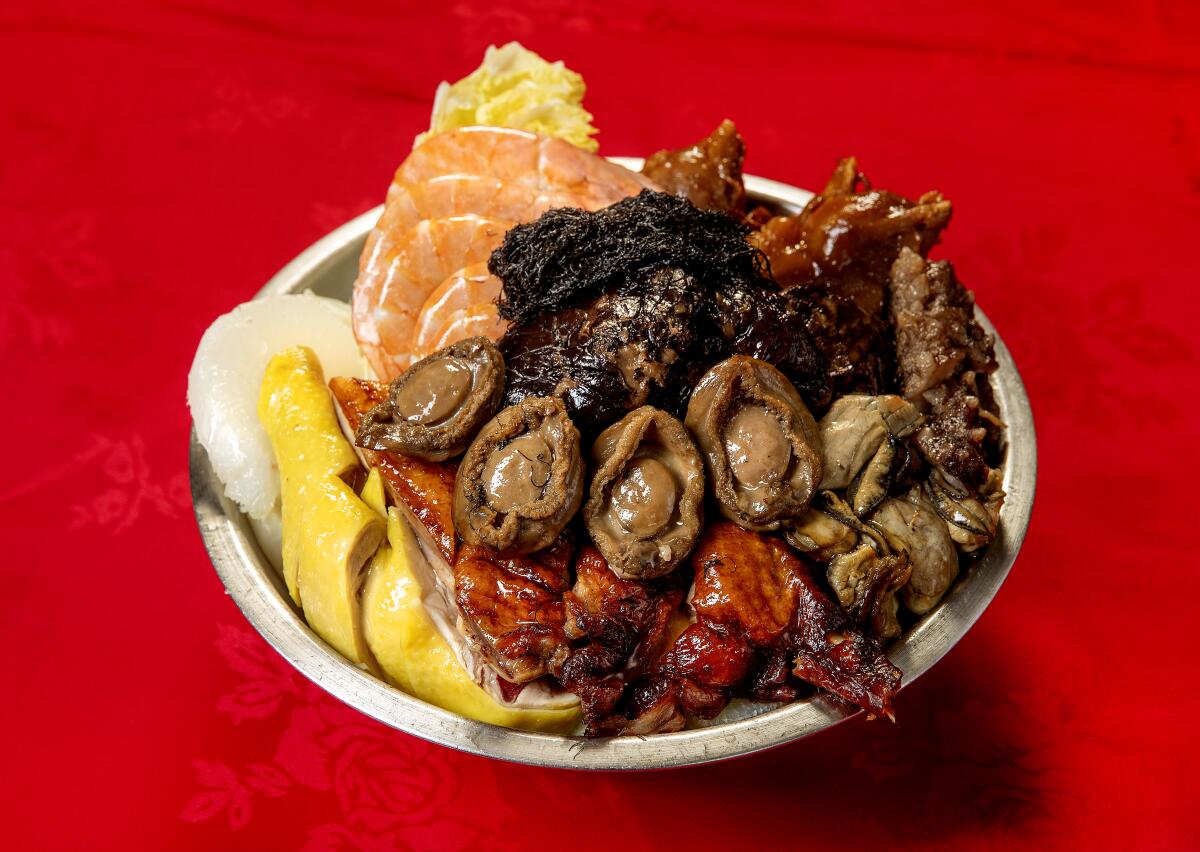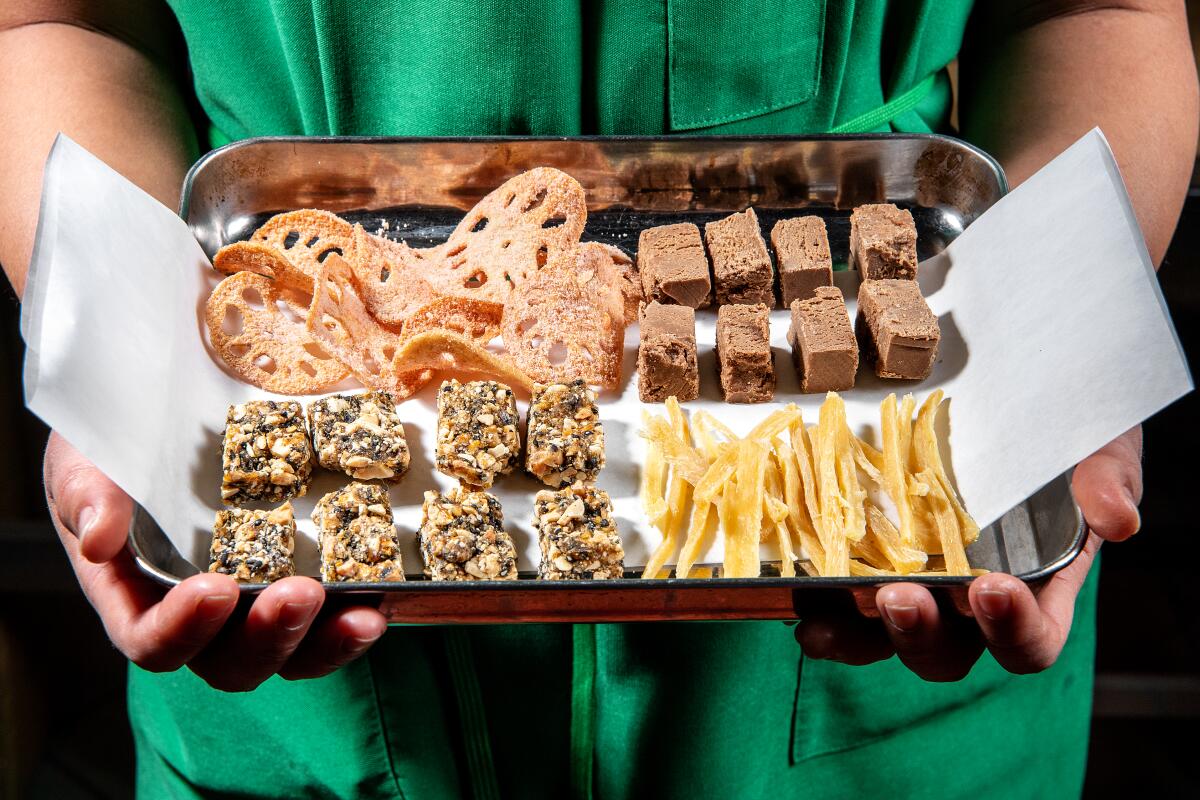A Cantonese Lunar New Year feast we could all use right now

- Share via
At Pearl River Deli, Johnny Lee’s tiny Cantonese restaurant in Chinatown’s Far East Plaza, weekends bring revolving specials that expand his short staple menu of char siu, silky scrambles and sandwiches. Come Saturdays there may be Hainan chicken rice, a longtime specialty of Lee’s, or sweet and sour pork that resurrects the dish’s original balanced dignity.
For this year’s Lunar New Year celebration, which begins Feb. 12, Lee is constructing his most elaborate dish since opening the restaurant a year ago — poon choi, a one-pot feast grounded in centuries of Cantonese culture.
The name (also phonetically spelled pun choi or, in Mandarin, pen cai) translates as “basin food.” Meats, seafoods and vegetables are added to a vessel in layers; most of the components are cooked individually before simmering in a sauce that helps them alchemize.
Lee begins with a base tier of daikon, which retains its pepperiness and yielding texture while absorbing the oceanic savor of abalone sauce (and soon, many other mingled flavors). Over the top he splays shrimp or spot prawns, dried scallops, fried tofu, and rehydrated mushrooms that act as umami blasters; sticky-crackly char siu; and various braised meats. It cooks only until every element warms. The final relationship among the ingredients should be like a well-orchestrated dinner party: lots of big, distinct personalities but also a collective intimacy that will never be repeated in quite the same way again.
Poon choi is by nature communal. Its genesis stems from walled villages, some built in the 1500s, by settlers in what became Hong Kong’s coastal New Territories. Folklore holds that country dwellers invented the dish to feed the emperor’s army, which was warring with Mongols during the Song dynasty.
“Its function as a dish was to feed a crowd with whatever was on hand,” says Lee F. Man, a Vancouver-based food writer whose parents have roots in the New Territories. “You know the people you’re eating it with well. We’re all sticking our chopsticks into the same pot.” He remembers simple versions from the region — and has followed its transformation into a vehicle for luxury ingredients in restaurants.
After Hong Kong reverted from British rule in 1997, poon choi was embraced as a proud culinary emblem of precolonial identity, a dish to showcase expensive dried seafoods and freshly roasted meats during banquets and holidays, especially Lunar New Year.
Scores of symbolic foods exist among the Asian cultures — and the 1.5 billion people — who celebrate the festival commemorating the first new moon of the annual lunar calendar.
I noticed my Cantonese friends mentioning poon choi this year in a way I can’t previously recall; a dish that engenders togetherness takes on new significance during a protracted global health crisis.
“Going to a celebration that involves poon choi is always about much more than the food itself,” says Janice Leung Hayes, a food writer in Hong Kong. “In pandemic times, the dish serves as a reminder of those celebrations that are so lively and full of people, happy noises and activity. In Cantonese this liveliness is called ‘yeet lau.’ It can’t really be translated, but yeet lau is the one thing we can’t have right now that’s so central to Chinese New Year’s celebrations.”
Like all businesses fighting to survive and maintain connections with their communities, Cantonese restaurants in Greater Los Angeles have adapted poon choi as takeout for smaller at-home gatherings. Most options for ordering the dish center in the San Gabriel Valley; the well-established dim sum and banquet specialists who opened in the 1980s and ‘90s coincided with an influx of immigrants arriving from the coastal Guangdong province (formerly known as Canton).

“Usually, we’d be serving 500 people for Chinese New Year,” said Simon Yung, a manager at Atlantic Seafood and Dim Sum in Alhambra, which takes to-go reservations for poon choi with three days’ notice. He remembers last year, as fears about the coronavirus began to spread during the seven-day holiday, when customer traffic dropped from full houses to a smattering of people within a week’s span.
Atlantic Seafood’s poon choi is a generous assemblage of classic Cantonese ingredients: rounds of daikon with bronzed roast pork, chicken, prawns, pork knuckle, fa cai (the soft, inky algae sometimes called “black moss vegetable”) and napa cabbage. Prized seafood, in this case abalone and braised sea cucumber, always crowns the very pinnacle of the dish. The meal comes in a steel bowl; Yung says many families rewarm the poon choi at home like a hot pot.
At Sea Harbour, a Rosemead restaurant that has long been one of the SGV’s most venerated dim sum palaces, a friend kindly translated the poon choi menu into English for me. The core dish costs $108 to feed four to six people, bowl included; the price is consistent with most area restaurants. It resembles the one from Atlantic Seafood, though with a multitude of add-ons available. They range from chrysanthemum leaves and South African abalone to luxury blowouts such as whole steamed Dungeness crab and Australian rock cod.
Every person with whom I spoke about poon choi stressed one point: Trust the place where you order the dish, because it takes skill to harmonize its elements.
“I’ve been to higher-end Hong Kong-style restaurants and asked about poon choi and they’ve been disdainful, like they wouldn’t ever serve such a common dish,” Man said. “It’s true that it can be a muddled mess. In a way it runs counter to every Cantonese cooking precept: lightness, freshness, separate care of each ingredient.
“But when it’s done well, it’s awesome. It coalesces into something that’s a greater whole. This is a somber New Year. It’s killing people not to be together. But skillfully made poon choi is a great shared experience, and we could all use that with our close families right now.”
Restaurants making poon choi
Here’s a short list of Cantonese restaurants making poon choi to celebrate Lunar New Year. Call ahead; the preparation usually takes several days and requires advance preparation:
Pearl River Deli: 727 N. Broadway, Los Angeles, (626) 688-9507, instagram.com/prd_la
Atlantic Seafood & Dim Sum Restaurant: 500 N. Atlantic Blvd., Monterey Park, (626) 872-0388, atlantic-seafood.net
Sea Harbour: 3939 N. Rosemead Blvd., Rosemead, (626) 288-3939, seaharbourrosemead.com
Ho Kee Cafe: 533 S. Del Mar Ave., San Gabriel, (626) 766-1076, also at 558 Las Tunas Drive, Arcadia, (626) 766-1076, togo.dylish.com/restaurant/ho-kee-cafe-arcadia
Capital Seafood: 333 E. Huntington Drive, Arcadia, (626) 574-8889, also at 755 W. Garvey Ave., Monterey Park, (626) 282-3318
More to Read
Eat your way across L.A.
Get our weekly Tasting Notes newsletter for reviews, news and more.
You may occasionally receive promotional content from the Los Angeles Times.










